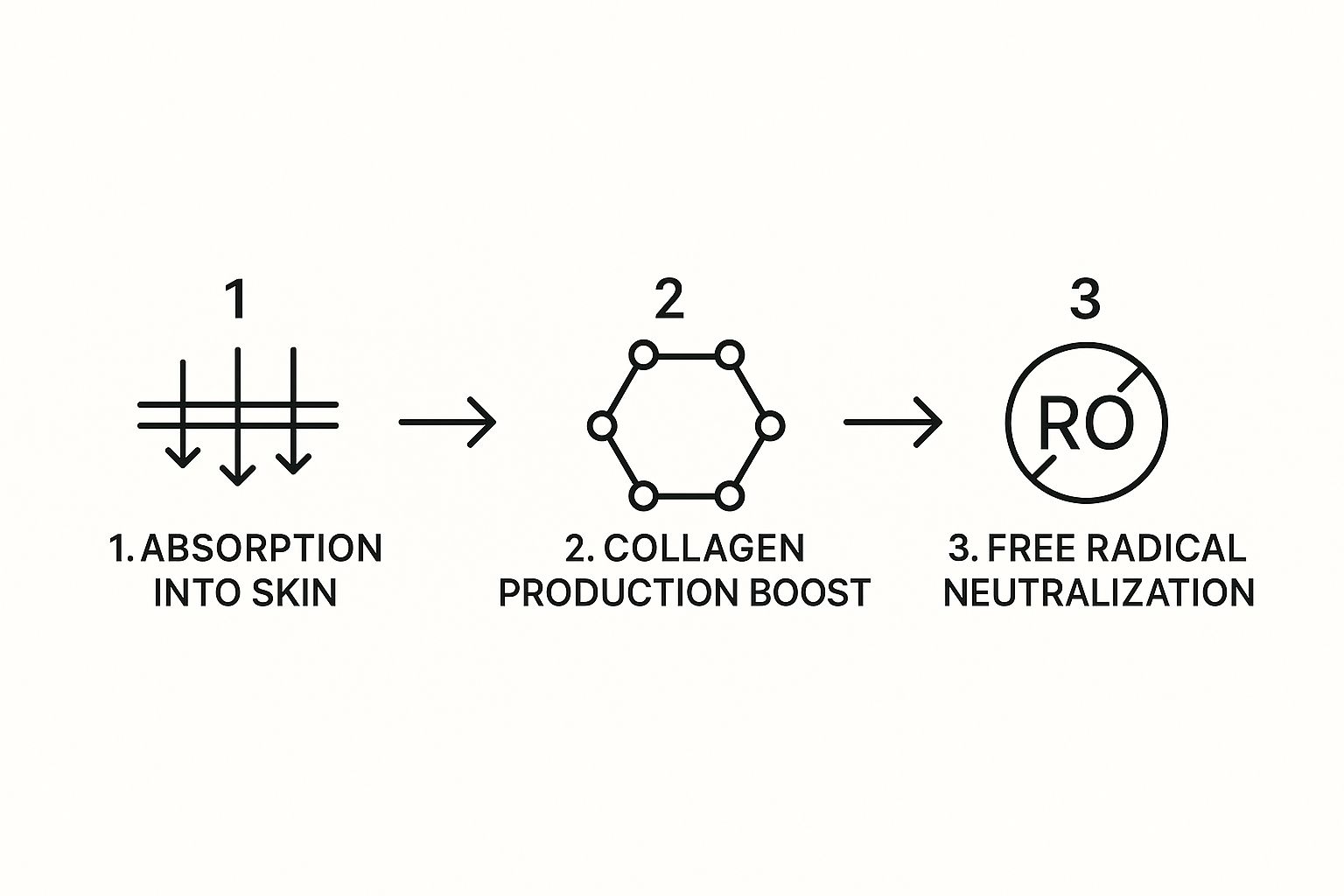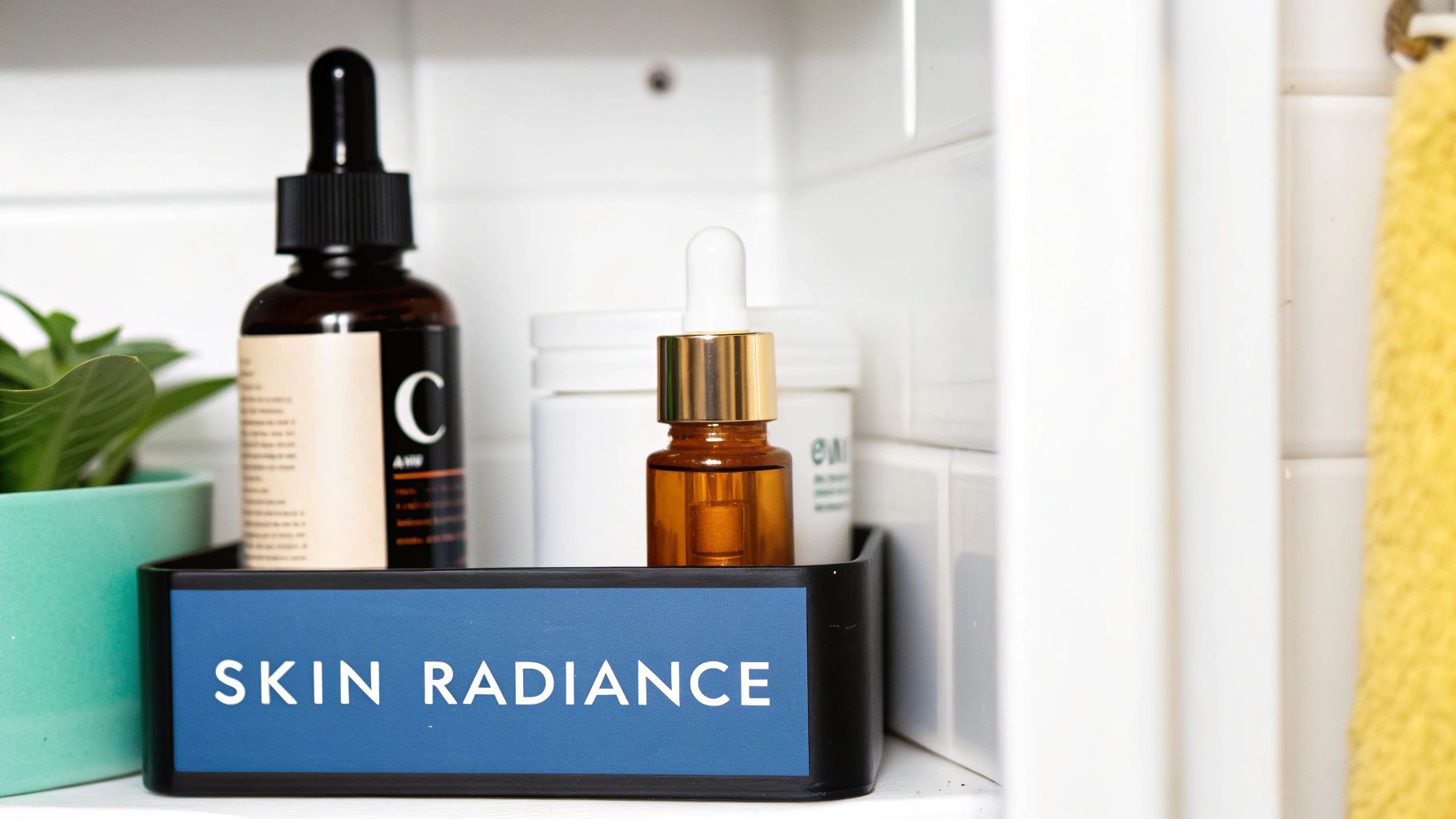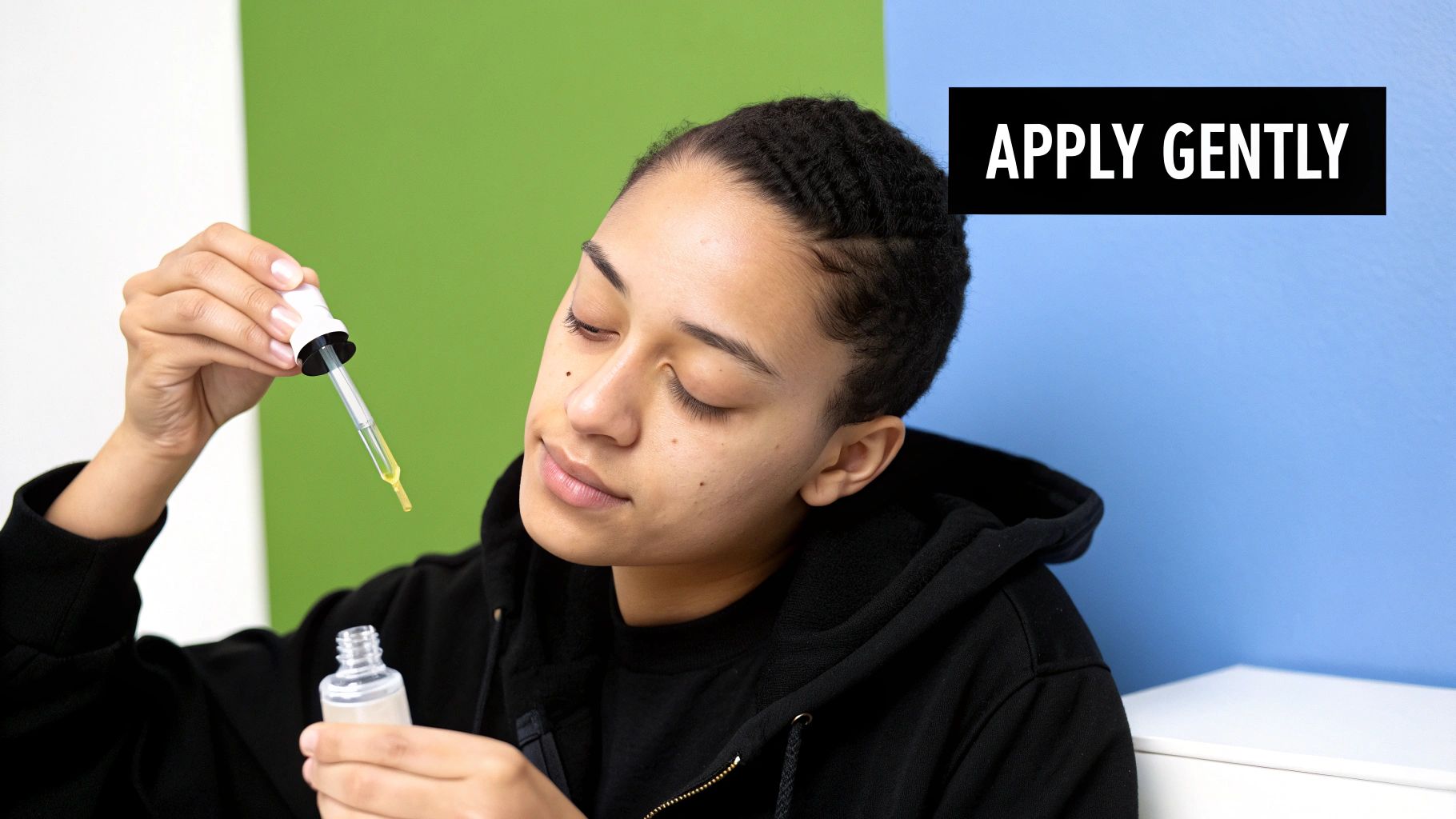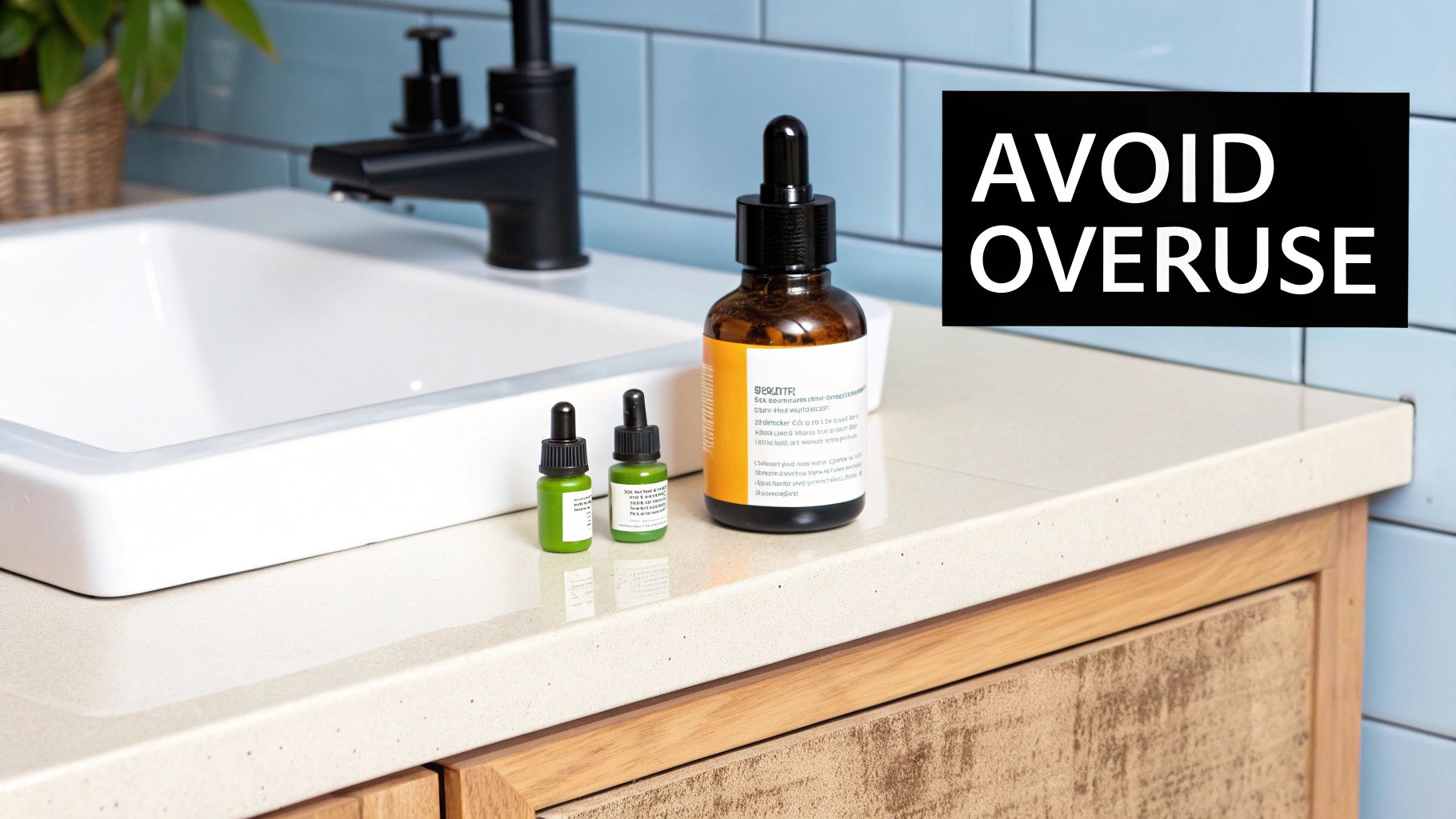How to Use Vitamin C Serum for Glowing Skin
- Blog Admin

- Jul 1
- 10 min read
So you’ve got your hands on a vitamin C serum and you’re ready for that incredible glow everyone talks about. The key to making it work is all in the timing: apply a few drops to your clean, toned face, but always *before* you put on your moisturizer and sunscreen. Getting this order right is what allows the powerful antioxidants to really sink in and do their job.
It’s the single most important step to make sure you get every last drop of goodness.
Why Your Skin Needs Vitamin C Serum
Think of vitamin C serum as your skin's personal bodyguard. Here in Canada, our skin faces a lot, from city pollution to surprisingly strong UV rays, even on cloudy days. A good vitamin C serum defends against all these daily stressors. But remember, consistency is everything if you want to see real, lasting improvements.
This image shows exactly what happens once the serum gets to work.

As you can see, it's a simple but powerful cycle: the serum absorbs deep into the skin, gets to work stimulating collagen, and neutralizes those pesky free radicals. This is what leads to that brighter, firmer, and more protected complexion over time.
The Science Behind the Glow
This isn't just skincare hype; the benefits of vitamin C for protecting and rejuvenating your skin are backed by solid clinical evidence. Its main job as an antioxidant is to fight off free radicals—those unstable molecules from pollution and UV exposure that break down our skin.
In fact, studies have shown that using it daily for at least three months can create a noticeable improvement in fine lines, wrinkles, and overall skin texture. It’s a true workhorse ingredient.
To make it crystal clear, here’s a quick rundown of the perfect morning application order. Following these steps ensures you're getting the most out of every drop.
Your Morning Vitamin C Application Routine
Step | Action | Why It Matters |
|---|---|---|
1. Cleanse | Wash your face with a gentle cleanser. | Removes dirt and oil, creating a clean slate for the serum to penetrate. |
2. Tone (Optional) | Apply your favourite toner. | Balances your skin's pH and can help the serum absorb even better. |
3. Apply Vitamin C | Gently pat 3-5 drops onto your dry face and neck. | This is the crucial moment for the active ingredient to absorb directly into the skin without any barriers. |
4. Moisturize | Wait a minute for the serum to dry, then apply moisturizer. | Hydrates your skin and helps to lock in the serum. |
5. Protect | Finish with a broad-spectrum sunscreen (SPF 30+). | Protects your skin from UV damage and boosts the effectiveness of your vitamin C. |
Getting this routine down is what turns this hero ingredient into a non-negotiable staple for radiant, healthy-looking skin.
Key Takeaway: Always apply your vitamin C serum to a clean, dry face before any heavier creams or oils. This is the golden rule for maximum absorption and getting the full protective benefits all day long.
Getting your daily routine right is the foundation for great skin. If you're looking to boost your results even further, professional treatments can complement your at-home efforts. For instance, many of our clients ask about the difference between popular exfoliating treatments. You can learn more by checking out our guide on microdermabrasion vs. chemical peels to see how they might fit into your overall skincare plan.
Choosing the Right Serum for Your Skin

Walking down the skincare aisle can feel a bit much, especially with all the vitamin C serums staring back at you. But trust me, finding the right one for your skin is the secret to getting that glow you're after. It’s all about matching the formula to your skin type and what you want to achieve.
First things first, let's talk about the type of vitamin C. L-Ascorbic Acid (L-AA) is the one you’ll hear about most often. It’s the purest, most powerful form and an absolute champion at tackling dullness and fine lines. The only catch? Its strength can sometimes be too much for really sensitive skin.
If your skin tends to react to new products, you're better off looking for a gentler version, like sodium ascorbyl phosphate. These are still fantastic antioxidants, but they’re much less likely to cause redness or irritation. They're a perfect entry point into the world of vitamin C.
Finding the Right Concentration
Now, let's talk numbers. It’s tempting to grab the bottle with the highest percentage, thinking more is always better, but that's not the case here. You want a sweet spot that's effective without being harsh.
Most of the research backs this up, showing that serums with a 10% to 20% vitamin C concentration give the best results for pigmentation and signs of aging, all with minimal irritation. This effective range is a big reason for its popularity in Canada, as you can see from market insights on Grand View Research.
Pro Tip: If you’re a total beginner with vitamin C or you know your skin is on the sensitive side, start with a 10% concentration. It’s a great way to let your skin get used to the ingredient before you even think about moving up to something stronger.
Why Packaging Is Important
Don't just look at what's in the bottle; look at the bottle itself. This is a big one. Vitamin C, especially L-Ascorbic Acid, is notoriously fussy. It breaks down and becomes useless when it's exposed to light, air, and heat—a process called oxidation.
To make sure your serum stays potent, always go for one packaged in a dark, opaque, or tinted glass bottle, ideally with an airless pump or a dropper that seals tightly. This isn't just for show; it’s crucial for protecting the formula. Given Canada's climate extremes, proper storage is key. Keep it in a cool, dark place (so, not your steamy bathroom!) to really get your money's worth.
Getting Your Application Technique Just Right
Okay, so you've picked out the perfect vitamin C serum. That's a great first step, but what you do next is what truly unlocks its power. The way you apply your serum is what turns a good product into a fantastic one, ensuring every precious drop gets absorbed right where it needs to.
Honestly, the right technique makes all the difference for your skin and your wallet.
Forget about aggressively rubbing products into your skin. A much better approach is a gentle ‘press and pat’ motion. After you put the serum on your fingertips, just lightly press it onto your face, then gently pat until it's spread out evenly. This little trick helps the serum sink in deeper without needlessly pulling or stretching your skin.
The 'Less Is More' Golden Rule
One of the biggest mistakes I see people make is thinking that slathering on more product will get them faster or better results. The truth is, your skin can only soak up so much at once. For most good-quality serums, a pea-sized amount—or about 3-5 drops—is plenty to cover your entire face and neck.
If your bottle recommends one pump, stick with that. Using the amount specified on the label is the most effective way for the product to work its magic, and it's much more economical in the long run.
Using any more than that is just a waste of a good serum. The extra product will just sit on the surface of your skin without giving you any added benefits.
Perfecting Your Morning Ritual
Sliding vitamin C into your morning routine should feel totally natural. After cleansing and toning, put the right amount onto your fingertips. Use that press and pat method to apply it, making sure to cover your face, neck, and even your décolleté.
Now, give it a moment. Let the serum fully absorb for about 60-90 seconds before you reach for your moisturiser. This short pause prevents that annoying pilling and makes sure each product in your routine can do its job properly. This simple, mindful step helps you get the full antioxidant shield you need to start your day.
How Vitamin C Fits in Your Skincare Routine

Figuring out exactly where to slot your vitamin C serum into your daily ritual is the secret to unlocking its full potential. You want to create a routine where every single product can do its job properly.
Here’s the golden rule I always tell my clients: Vitamin C is a morning person. Its true power shines as an antioxidant, shielding your skin all day from environmental aggressors like city pollution and UV rays—a daily reality for most of us here in Canada.
When you apply it in the morning, right after cleansing but before your moisturizer and sunscreen, you’re setting up a powerful protective barrier. Trust me, this timing is crucial if you want to get the maximum defensive benefits from your serum.
The Power of Product Pairing
To get the absolute most out of your vitamin C, it’s helpful to know which ingredients are its best friends and which it should keep its distance from. Think of it like building a dream team for your skin; you need players that complement and boost each other’s performance.
Some ingredients create an incredible synergy with vitamin C, making it more stable and effective. When you find a serum formulated with these, you know you’re holding a well-rounded, potent product.
Vitamin E: This is another powerhouse antioxidant. It works hand-in-hand with vitamin C to provide a double layer of protection against environmental damage.
Ferulic Acid: This one is a true superstar. It helps stabilize both vitamin C and E, making them work better and last longer on your skin. You get more bang for your buck.
Hyaluronic Acid: While vitamin C is busy brightening and protecting, hyaluronic acid steps in to deliver intense hydration, leaving your skin looking plump, dewy, and feeling fantastic.
Ingredients to Keep Separate
On the other side of the coin, some active ingredients can clash with vitamin C. This can cause unnecessary irritation or, just as bad, make both products less effective. The simple solution is to use them at different times of the day.
A common example is Benzoyl Peroxide, often found in acne treatments. It can actually oxidize vitamin C, which basically renders it useless. The best approach is to use your benzoyl peroxide product at night and save your vitamin C for the morning.
A question I get all the time is about using vitamin C with retinoids. To avoid any potential irritation and let each ingredient work its magic, I always recommend using your vitamin C serum in the AM for protection and your retinoid at night for cell turnover and repair.
This simple separation ensures every active in your routine can perform its specific job without interference. Building your routine with this knowledge is a game-changer for getting better results. For those focusing on rejuvenation, our complete Canadian guide on how to improve skin texture has even more expert advice to help you on your journey.
Common Mistakes to Avoid for Better Results
Even the absolute best vitamin C serum won't work its magic if a few simple mistakes creep into your routine. It's surprisingly easy to get in your own way, preventing you from seeing that bright, even-toned complexion you’re after. Let's make sure you sidestep these common slip-ups so your serum can deliver.
A frequent misstep I see is applying vitamin C to damp skin. While this trick works wonders for some hydrating products, it’s a no-go for vitamin C. It just dilutes the formula, weakening its potency before your skin even gets a chance to absorb it. Always, always pat your face completely dry after cleansing.
Another big one is how you store your serum. Vitamin C is notoriously fussy and breaks down when it sees light, heat, or air. This process is called oxidation, and it’s the enemy of an effective product. If you notice your serum turning dark orange or brown, it’s past its prime and won't do you any good. Time to toss it.
Using Too Much and Expecting Too Little
It’s tempting to slather on extra product, thinking more equals faster results. But with skincare, that’s usually a myth. Your skin can only absorb so much at once.
Using more than the recommended 3-5 drops is just a waste of good serum (and your money!), as the excess will just sit on top of your skin.
The most overlooked mistake? Impatience. You might see a subtle glow within a few weeks, but tackling bigger concerns like dark spots takes time. Real, lasting results come from consistent, daily use over several months.
Finally, remember that a vitamin C serum is all about protecting your skin and gradually improving its health. This works hand-in-hand with a healthy skin cycle. You can learn more about why skin renewal is essential for vibrancy in our guide, which explains how cell turnover supports your daily antioxidant protection for an even better outcome.
Your Vitamin C Questions Answered

Even after you get the hang of how to use vitamin C serum, it’s completely normal to have a few more questions pop up. We get it! So, let's clear up some of the most common things we hear from our Canadian clients. Our goal is to make sure you feel totally confident adding this powerhouse to your skincare routine.
Can I Use Vitamin C Serum Every Day?
Yes, absolutely! In fact, for the best results, we highly recommend it. Using it every single morning is the key to building up that antioxidant protection in your skin. Think of it as your daily defence against environmental stressors like pollution and UV rays.
If your skin is on the sensitive side, you might want to start slow. Try applying it every other day at first to let your skin get used to it, then gradually work your way up to daily use.
Here's the key thing to remember: Vitamin C is your daytime shield. When you apply it in the morning, you're protecting your skin from damage throughout the day. Using it at night is fine, but you miss out on that immediate defensive boost against the environment.
How Long Until I See Results from Vitamin C?
This is probably the number one question we get, and the honest answer is: patience is everything. You might notice your skin looking a little brighter or healthier within a couple of weeks, but the big, visible changes take time.
For things like fading dark spots and seeing a much smoother skin texture, you'll need to stick with it for at least three to four months of consistent, daily use. Trust us, the long-term glow and anti-aging perks are more than worth the wait.
Does Vitamin C Replace My Sunscreen?
Not a chance. This is a big one. Think of vitamin C and sunscreen as a power couple—they work so much better together. Your serum helps fight off the free radical damage that your sunscreen can't completely block on its own.
But, and this is crucial, vitamin C has zero SPF protection. You must always finish your morning routine with a broad-spectrum sunscreen of at least SPF 30. No exceptions! The Canadian Cancer Society recommends this as a baseline for daily protection, making it a non-negotiable step to truly shield your skin from harmful UV rays.
Why Did My Vitamin C Serum Change Colour?
If your once-clear or light-coloured serum has turned dark orange or brown, it’s a sign that it has oxidized. This happens when the formula is exposed to too much air, light, or heat. When it oxidizes, the vitamin C breaks down and is no longer effective.
An oxidized serum won't give you any of the benefits and could even irritate your skin. It’s best to just toss it and start fresh with a new bottle. That way, you know you're getting the antioxidant power you paid for.
Ready to achieve your best skin yet with expert guidance? At Skinsation Aesthetics Inc., we provide advanced skincare solutions tailored to you. Discover our services and start your journey to radiant skin by visiting https://www.skinsation.me.


Comments